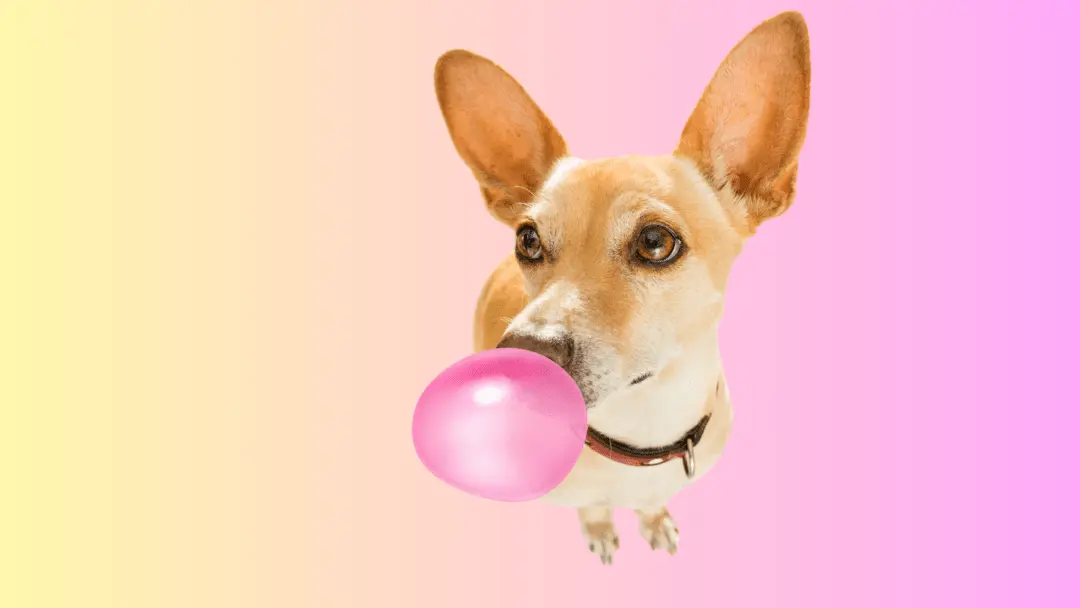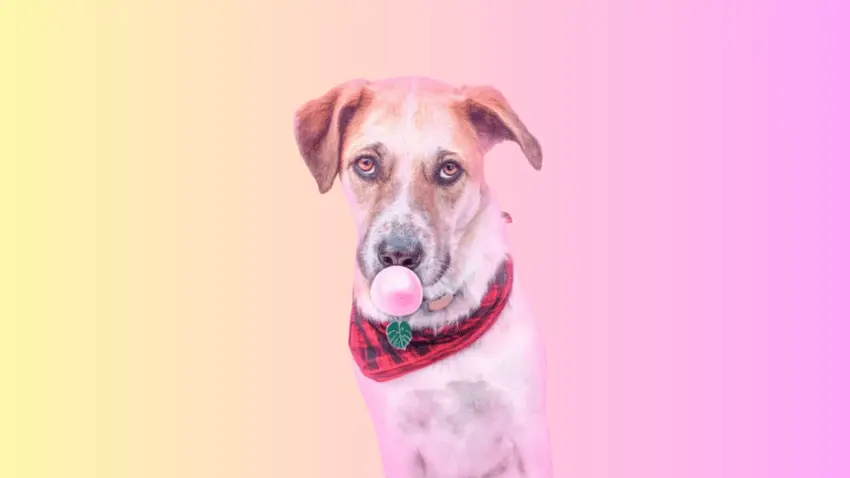What To Do If Your Dog Eats Gum? 3 Things You Should Do
Dogs eat things they aren’t supposed to. From squeaker toys, socks, to your paperwork – they just love chewing.
However, this habit can become deadly when the dog comes across your chewing gum.

Whether it’s already chewed or not, gum can lead to severe poisoning. This is why you should know what to do if your dog eats gum by accident.
Here, I will discuss why chewing gum is dangerous for dogs and what you should do if your pet swallowed one.
What To Do If Your Dog Eats Gum? 3 Things To Do

1. Watch out for xylitol poisoning
Uninformed pet owners will think that gum ingestion is nothing to worry about. Sure thing, your dog can pass it through stool, but the biggest enemy here is xylitol.
Chewing gums contain a substance called xylitol, natural alcohol used commercially as a sugar substitute.
It’s widely found on oral care products, pharmaceuticals, and a lot of food products like sugarless gum. Many manufacturers prefer xylitol because it’s as sweet as table sugar but with fewer calories.
Xylitol is safe for humans, but it’s the total opposite for dogs. When ingested, xylitol will trigger a serious case of poisoning in canines.
It will lead to hypoglycemia, liver failure, seizures, and even death.
So why is this happening? In human bodies, xylitol doesn’t trigger the release of insulin.
But with dogs, xylitol triggers a massive and quick release of insulin from the pancreas. This happens because xylitol becomes absorbed in the dog’s bloodstream almost instantly.
Such a rapid increase in insulin supply will cause low blood sugar (hypoglycemia). Insulin is responsible for regulating blood sugar levels, but it will overdo its job if released in excessive quantities.
On the other hand, canine hypoglycemia interferes with the liver’s ability to make glucose buildup. Such buildup is necessary, so the liver can release it when your body signals a need for it.
If your dog ingested large amounts of xylitol-laced gum, it could suffer from liver failure.
To prevent all of these complications from putting your dog’s life at risk, you should identify the initial symptoms of xylitol poisoning. The following are some of the tell-tale signs:
- Lethargy
- Vomiting and diarrhea
- Tremors
- Difficulty standing or walking
- Collapse
- Bodily incoordination
Take note that xylitol poisoning takes place fast after your dog ingested the gum. Most of the time, it will only take 30 minutes for your dog to show the initial symptoms.
However, some canines with a slower metabolism may take up to 12 hours to show signs of poisoning. What’s important is you remain proactive the moment you discover that your dog ate gum.
Also, there are cases when gum causes intestinal blockage in dogs.
2. Call your dog’s vet right away
The moment you saw your dog eat chewing gum, you should call the vet right away. You shouldn’t wait for your dog to exhibit symptoms before doing something.
When this happens, the poisoning would be advanced, and it might be too late for your pet.
In some cases, the vet will instruct you to induce vomiting using hydrogen peroxide. Take note that you should never do this unless the vet instructed you to do so.
To induce vomiting in dogs, the vet will teach you how to make the proper dilution. The dosage will depend on your dog’s size, weight, and health condition.
Veterinarians hope that by inducing vomiting, your dog will spit out the gum. But even if the canine did vomit the gum, you still have to bring it to the vet’s clinic.
The veterinarian would have to check your dog’s blood sugar level. If your dog’s condition is already worsening, the vet will go straight to treatment.
Your dog will receive blood sugar stabilizers. If need be, the vet may also administer a liver protectant to prevent organ failure.
Dogs suffering from severe xylitol poisoning would have to stay in the vet’s clinic for days. The treatment will continue until your dog passes the gum and has its blood sugar level stabilized.
Depending on the extent of poisoning, vet fees can range from $250 to $5,000.
3. Alternative option: contact a pet poison hotline
If your dog ate chewing gum in the middle of the night, there’s a high chance that you can’t contact the vet. During this situation, you should call a pet poison hotline.
One of the most popular and reliable options is the ASPCA Animal Poison Control hotline at (888) 426-4435. They are on-call 24/7, 365 days a year.
You’ll get to talk to a pet poison expert who will evaluate the situation and instruct you to perform first aid. Just note that they charge consultation fees.
Another option you have is the Pet Poison Helpline at (855) 764-7661. Like the ASPCA hotline, Pet Poison Helpline is on-call 24/7 for any poison and any pet.
They have experts who will assess the situation and help you manage the poisoning. They charge a $65 incident fee, and you can also avail of follow-ups.
How to prevent your dog from eating gum?

Like the trite line goes, prevention is always better than cure. After your dog has been treated, you should aim for prevention with these tips:
-
Chew something else
If you’re fond of chewing gum, you should consider chewing somewhere else. Personally, I used to chew gum for my jaw problem, but I switched to xylitol-free mint chews.
You can also consider licorice, ginger, or parsley if you like the taste.
Dogs chewing on objects is a normal behavior. It also relieves boredom and anxiety. Dog chew toys are also available to satisfy this natural instinct.
-
Mind where you throw your gum
Dogs are scavengers, so they can easily pick up gum you spit into the bin especially if it is at the top of the bin. You should always cover your trash can and never spit out gum in your yard.
You can also wrap the gum in a paper before you throw it in the bin.
-
Store the gum properly
When it comes to keeping things away from dogs, you have to treat them like toddlers. If you store your gum in your back pocket or purse and the dog can easily get to them, you need to reconsider these placs.
You should place your chewing gum on an elevated cabinet inside a tightly sealed jar where it is difficult for your dog to reach.
-
Inform your family
Kids love chewing gum, and they love sticking it under tables and hidden surfaces. When you’re not looking, the dog will snack on it.
Make sure that you discuss the repercussions of leaving gum around to your kids to prevent another case of xylitol poisoning.
Can A Dog Survive After Eating Xylitol?
Xylitol severely affects the liver of dogs and causes the enzymes of the liver to elevate. The increase in enzyme levels eventually leads to liver failure which is a fatal condition.
However, if the enzyme upsurge is mild, the dog can fully recover from xylitol toxicity.
Although, some dogs can tolerate a small amount of xylitol ingestion. But just because your dog doesn’t suffer from adverse effects doesn’t mean you’re going to feed it with xylitol-mixed food.
You’ll never know when the compounding effect of the substance will soon take its toll on your dog’s health.
How Much Xylitol Does It Take To Kill A Dog?
Xylitol toxicity is very high in dogs. Even a small dose of 0.1 grams of xylitol is enough to cause hypoglycemia on canines.
On the other hand, 0.5 grams is enough to cause liver failure.
The dangerous thing here is that most sugar-free gum will have around 0.3 to 1 gram of xylitol in them.
This is why a single gum is enough to send a dog to a vet clinic’s emergency room. And if you have a small breed, the effects would be much worse.
Even if it’s already chewed gum, there will still be xylitol left in it. You shouldn’t be too complacent, or your dog will suffer from the consequences.
How Long Does Xylitol Stay In A Dog’s System?
It usually takes a dog up to 4 hours to fully absorb xylitol on its system. However, the peak plasma levels would be achieved within 30 minutes upon ingestion.
This is why you should act fast once your dog ingests the gum. The best move is to bring the dog to the vet’s clinic or call the vet as soon as possible.
You should never wait until your dog is showing symptoms.
Which Chewing Gum Has The Most Xylitol?
Epic Xylitol Gum has the most xylitol of all the gums I’ve tried. It’s 100% sweetened with xylitol, with each 1.5-gram piece containing around 1.06 grams.
Just imagine your dog ingesting this. The result would be catastrophic.
Other chewing gum brands with xylitol content are Orbit, Mentos, Stride, Trident, Pure, and Icebreakers.
Take note that many gums packaged on car cups have increased xylitol content due to their candy coating. You should keep all of these away from your dog at all times.
Also, some Trident gums don’t have xylitol but still contain artificial sweeteners.
Conclusion
Knowing what to do if your dog eats gum can be life-saving. You have to seek veterinary care for your pet as soon as possible to combat the effects of poisoning.
Also, you shouldn’t try to induce your dog’s vomiting on your own. If done wrong, it will put your pet’s life at a much greater risk.
You should take precautionary measures to prevent such accidents from happening. If your dog ingests gum and you notice abnormal signs, you should contact your veterinarian immediately.
I hope this article will help you prevent such accidents and cope with them better if they happen.
Thank you for reading!
